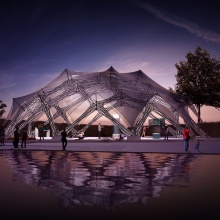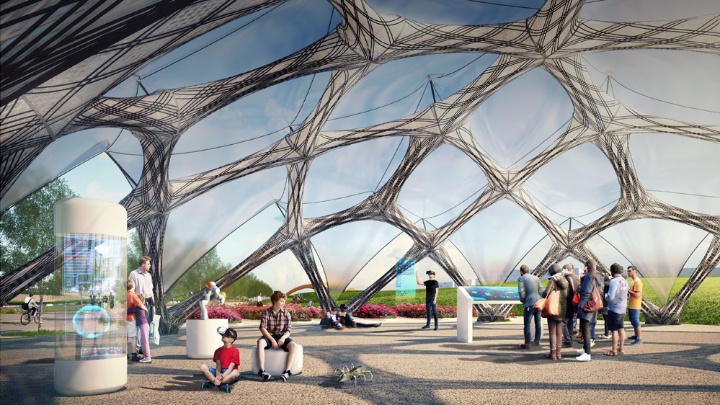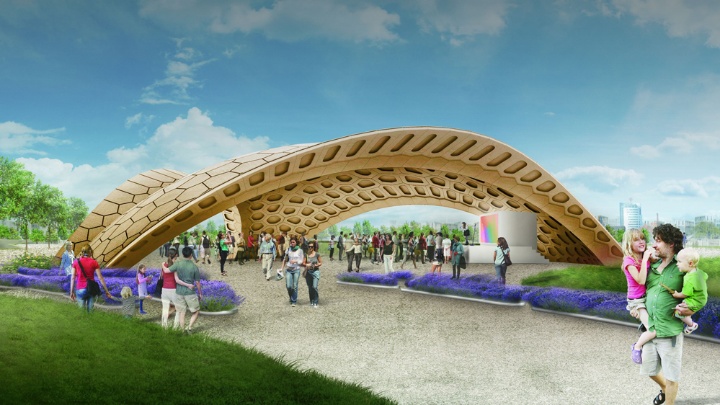- National Garden Show for the first time symbiosis of garden and city exhibition
- Bionic pavilions as lightweight constructions made of wood and carbon fibre
- Completely digital planning and production
- Financing by the State of Land Baden-Württemberg
The National Garden Show Heilbronn 2019 (BUGA) is a unique festival at which the city will welcome an audience of millions from the whole of Germany. Framed by a powerful setting of vineyards, riverbanks and industrial buildings, the National Garden Show is growing in the middle of the city on a compact site between old Neckar and Neckar Canal. With this as its engine a 40-hectare former wasteland is turning into a green oasis and a National Garden Show that has not existed up to now as a unique combination of garden and city exhibition.
Great horticultural skills and high-quality urban architecture are developing a symbiosis for the first time in the almost 70-year history of the National Garden Shows. Information und inspiration on the topic of garden combine with experience, entertainment, relaxation and life in a waterside city.
“With this new National Garden Show format in Heilbronn 2019 we are risking an experiment“, said Hanspeter Faas, Managing Director of the National Garden Show Heilbronn 2019 GmbH. “But we are convinced that we are on a pioneering and successful path with our concept of playing garden topics and future topics parallel to each other. To date no garden show has been so multifaceted, diversified and compacted as the Heilbronn show will be.”
As the largest funding body, the State of Baden-Württemberg will also be taking a prominent place at the National Garden Show Heilbronn 2019. Baden-Württemberg will be presenting two highly innovative lightweight constructions made of the materials wood and carbon fibre in the middle of nature by financing two pavilion structures on the summer island – one centrally located, hill-modelled flower and recreation landscape between two newly planned lakes on the site.
Each with a space of 500 square metres, both structures are unique worldwide as completely digitally planned and manufactured pavilions. Two institutes from the University of Stuttgart were commissioned with building the experimental pavilions: the Institute for Computational Design and Construction (ICD) under the management of Professor Achim Menges and the Institute of Building Structures and Structural Design (itke) under the management of Professor Jan Knippers.
“We are delighted about the cooperation with the University of Stuttgart that will be presenting cutting edge architectural research in Heilbronn“, said BUGA Managing Director Mr Faas. “Both pavilion structures fit in very well with our Garden Show and embody as one of the many highlights the future-oriented quality of our exhibition.“
Professor Wolfram Ressel, Rector of the University of Stuttgart, pointed out that the pavilions are architecturally rooted in the tradition of Frei Otto to Jörg Schlaich and said: “The performance strength of our faculty “Architecture and Urban Development” is making an internationally widely acclaimed contribution for Baden-Württemberg as an important centre of lightweight constructions, bionics and the use of digital technologies in architecture. The pavilion structures embody the typical state innovation strength by them being given a specific and tangible form.“
Bionic fibre pavilion
Compared to technical systems, biological structures generally display a significantly higher degree of high-performance and material efficiency. The transfer of light construction principles such as the load-specific differentiation of material and structures enable the development of new construction forms for architecture in connection with digital planning, simulation and manufacturing processes. The load-bearing structure of the fibre pavilion comprises exclusively composite components, whose individual structures made of glass fibres and carbon fibres are manufactured in a robotic manufacturing process. This enables adapting the geometry and fibre arrangement of each one of the 60 components specifically to the respective requirements. In so doing an exceedingly efficient lightweight construction and a unique architectural effect is produced.
Bionic wooden pavilion
Board structures are a particularly interesting type of construction in nature. Biological role models are characterised by segments with specific functions and differentiated shapes. For this reason the design, the construction and manufacturing of segmented shell structures have been researched by both institutes for many years on the basis of bionic principles. The shape of each segment as well as the design of an efficient connection are thereby of special importance. The principle of the morphological adaptation can be coupled through a digital design and simulation process and implemented with a robotic production. The segments of the wooden pavilion at the National Garden Show will be produced for the first time as hollow cassettes that are assembled from boards and beams in a robotic pre-assembly process. The wooden pavilion will comprise 400 such cassettes and will span an event room that is 25 metres wide.
Contact:
Bundesgartenschau Heilbronn 2019 GmbH
Suse Bucher-Pinell I Press Spokesperson
Edisonstraße 25 I 74076 Heilbronn
Tel.: 07131 - 27 14 - 158
presse@buga2019.de I www.buga2019.de
University of Stuttgart
Dr. Hans-Herwig Geyer I Head of University Communication and Press Spokesperson
Keplerstraße 7 I 70174 Stuttgart
Tel.: 0711 - 685 - 82555
hkom@uni-stuttgart.de I www.uni-stuttgart.de




